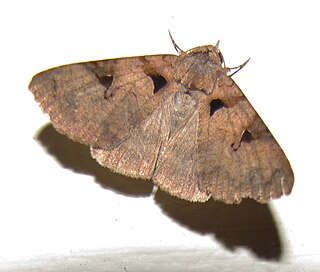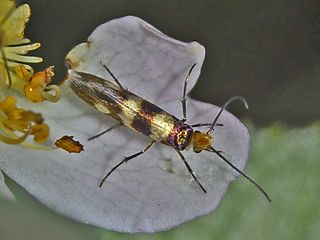
Orthonama obstipata, the gem, is a moth of the family Geometridae. The species was first described by Johan Christian Fabricius in 1794. It is a cosmopolitan species. In continental Europe though in the northeast, its range does not significantly extend beyond the Baltic region and it is absent from northern Russia. This well-flying species is prone to vagrancy and able to cross considerable distances of the open sea; it can thus be regularly found on the British Isles and even on Iceland.

Paracolax tristalis, the clay fan-foot, is a litter moth of the family Erebidae. The species was first described by Johan Christian Fabricius in 1794. It is found in the Palearctic realm.

Speiredonia mutabilis is a species of moth of the family Erebidae first described by Johan Christian Fabricius in 1794. It is found in India, Sri Lanka, Vietnam, Taiwan, the Philippines, from Sundaland eastwards to Australia, the Solomon Islands, New Caledonia, Vanuatu, Fiji and Tonga.

Avatha discolor is a species of moth of the family Erebidae. It is found from the Indo-Australian and Pacific tropics to as far east as Henderson Island.

Prochoreutis myllerana, Miller’s nettle-tap or small metal-mark, is a moth of the family Choreutidae found in Asia and Europe. Miller's nettle-tap was first described by Johan Christian Fabricius in 1794 from a specimen found in Sweden.

Hypocala deflorata is a moth of the family Erebidae. It was first described by Johan Christian Fabricius in 1794. It is widespread from India, Sri Lanka to Africa and to Australia and many Pacific islands. Records include China, Borneo, Queensland, Vanuatu, New Caledonia, Rotuma, Fiji, Samoa, Hawaii, Norfolk Island and New Zealand.

Simplicia cornicalis is a litter moth of the family Erebidae. The species was first described by Johan Christian Fabricius in 1794. It is found in south-eastern Asia and the Pacific. Records include New Caledonia, Réunion, Thailand, Fiji, Hawaii, India, Sri Lanka, the Society Islands, as well as New South Wales and Queensland in Australia. It is an introduced species in southern Florida and Louisiana in the United States.

Micropterix allionella is a moth of the family Micropterigidae. It was described by Johan Christian Fabricius in 1794.

Hodebertia is a genus of micro-moth of the family Crambidae. It contains only one species, Hodebertia testalis, and is found in the tropics, but ranges north to parts of Europe on occasion.

Oraesia emarginata is a species of moth of the family Erebidae first described by Johan Christian Fabricius in 1794. It is found in Australia, New Caledonia, Indonesia, New Guinea, Pakistan, the Philippines, India, Sri Lanka, Sulawesi, Taiwan, China, Japan, Korea and Nepal as well as Eritrea, Ethiopia, Kenya, Namibia, Nigeria, South Africa, Tanzania, the Gambia, Uganda, Oman and Yemen.
Calyciphora albodactylus is a moth of the family Pterophoridae. It is found in most of Europe, except Portugal, the Benelux, Great Britain and Ireland. It is also known from Russia and Anatolia. The species was first described by Johan Christian Fabricius in 1794.

Javesella pellucida is a species of insect in the family Delphacidae. It is found in most of Europe, China, Georgia, India, Japan, Kazakhstan, Kyrgyzstan, Mongolia, Turkey, Uzbekistan, Algeria, Libya, Morocco, most of North America, Central America, Cuba and Puerto Rico.

Miris is genus of true bugs belonging to the family Miridae, subfamily Mirinae. The genus was first described in 1794 by Johan Christian Fabricius.

Philipomyia is a genus of horse fly belonging to the family Tabanidae subfamily Tabaninae.

Agathia laetata is a species of moth of the family Geometridae which was first described by Johan Christian Fabricius in 1794. It is found in India, Indochina, southern China, Taiwan and Sundaland.

Amyna punctum is a moth of the family Noctuidae first described by Johan Christian Fabricius in 1794. This moth can be found throughout subtropical African countries such as South Africa, Madagascar and Australasian countries like India, Sri Lanka, the Philippines, Borneo and the Andaman Islands.

Haplotinea insectella, the drab clothes moth or fungus grain moth, is a moth of the family Tineidae. It was described by Johan Christian Fabricius in 1794. It is found in all of Europe, except Ireland, the Iberian Peninsula and the western and southern part of the Balkan Peninsula. It is also found in North America. The species is often found in warehouses, granaries, mills and farm buildings.

Bombus mixtus is a species of bumblebee. It is native to western North America, where it occurs in western Canada and the United States. It is also disjunct in the Great Lakes region. It is known commonly as the fuzzy-horned bumblebee, tricoloured bumblebee, orange-belted bumblebee, and mixed bumblebee.

Eriopygodes imbecilla, the Silurian, is a moth of the family Noctuidae first described by Johan Christian Fabricius in 1794.

Epinotia abbreviana is a moth of the family Tortricidae. It is found in Europe and was first described by Johan Christian Fabricius in 1794.



















